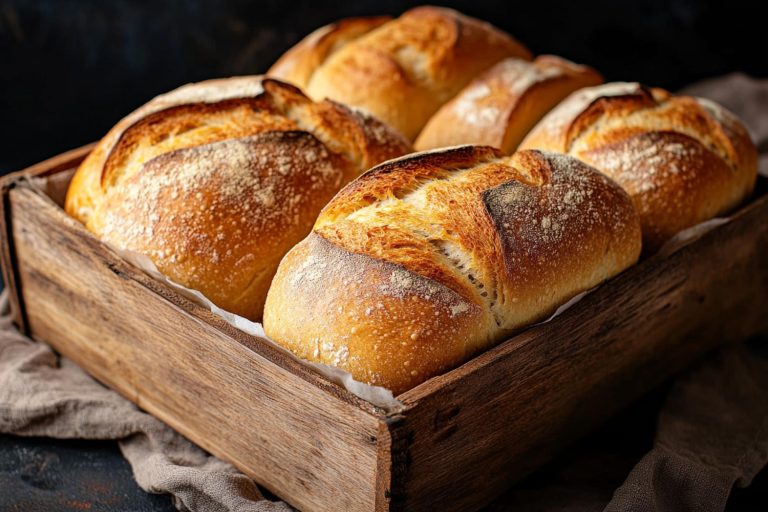How to Make Homemade Sourdough English Muffins: A Step-by-Step Guide
Nothing compares to fresh homemade sourdough English muffins with their signature nooks and crannies. These breakfast classics transform beautifully through natural sourdough fermentation, creating a perfect balance of tangy flavor and chewy texture. You can achieve professional-quality results with simple ingredients and kitchen equipment at home.
In this complete guide, let me walk you through each stage of the sourdough English muffin process. You’ll learn everything from keeping an active sourdough starter to becoming skilled at bulk fermentation and proper cooking techniques. The detailed instructions will give a clear path to mixing, proofing, shaping, and cooking methods that produce golden, flavorful muffins ready to toast and serve.
What You’ll Need
Quality ingredients and the right equipment make perfect sourdough English muffins at home. Let me show you what you need to create these tasty breakfast favorites.
Ingredients
Here’s what you need to make perfect sourdough English muffins:
Base Ingredients:
- 3 cups (360g) bread flour or 3⅓ cups (400g) all-purpose flour
- 1 cup active sourdough starter (100% hydration)
- 1½ cups whole milk or 2% milk
- 2 tablespoons honey
- 1½ teaspoons salt
- two tablespoons unsalted butter, melted and cooled
- Cornmeal or semolina flour for dusting
Your choice of ingredients affects the final result by a lot. Bread flour gives you a chewier texture and better-defined nooks and crannies because of its higher protein content (around 13%). Ensure your sourdough starter is active and bubbly with signs of recent feeding. Whole or 2% milk works best and helps create a tender crumb structure.
Equipment
The right kitchen tools will make your baking journey easier. Here’s what you need to create perfect homemade sourdough English muffins:
Primary Equipment:
- Large mixing bowl to prepare dough
- 3-inch biscuit cutter or drinking glass to shape muffins
- Heavy-bottomed 12-inch skillet with lid
- Baking sheets lined with parchment paper
- Kitchen scale to measure ingredients
- Wire cooling rack
- Instant-read thermometer
You don’t need a stand mixer – these muffins are great when hand-made. A cast iron skillet will give you the best results because it spreads heat evenly during cooking. Your kitchen scale helps measure flour and starters accurately so each batch turns out the same.
Additional Helpful Tools:
- Bench scraper to handle dough
- Plastic wrap or damp towel to cover
- Measuring cups and spoons
- Non-contact infrared thermometer to check surface heat
- Spatula to flip muffins
The right temperature makes a big difference in fermentation. Tools that monitor both room and cooking temperatures will give you better results. This combination of equipment helps you develop, shape, and cook these artisanal sourdough English muffins perfectly.
Preparing the Sourdough Starter
A sourdough starter that you keep active is crucial to making exceptional homemade sourdough English muffins. This natural leavening agent helps the muffins rise and creates their distinctive tangy flavor and chewy texture.
Feeding Your Starter
A healthy sourdough starter needs regular feeding and attention. Room temperature and your desired fermentation timeline determine the ideal feeding schedule. Bakers should feed their starter 4-12 hours before making muffins. The recommended feeding process follows these steps:
- Remove starter from storage
- Discard all but 75 grams of mature starter
- Add flour mixture (75% all-purpose, 25% whole wheat)
- Mix with water at a 1:4:4 ratio (starter:flour: water)
- Let ferment at room temperature
Pro Tip: The starter’s tangy flavor improves when used about 2 hours after its peak. Just remember to reduce the recipe’s starter amount by 15 grams.
Signs of an Active Starter
A ready-to-use starter is a vital part of making great sourdough English muffins. Your starter must be at least 14 days old before you can use it, and it takes 3-4 months to reach full maturity. These signs tell you your starter is ready:
- Volume: Doubles consistently within 4-6 hours after feeding
- Appearance: Shows a domed surface with bubbles breaking on top
- Texture: Thick, like warm peanut butter, with a stretchy, elastic quality
- Aroma: Pleasant, yeasty smell without sharp or unpleasant odors
- Structure: Reveals honeycomb-like bubble network when you tilt the jar
- Consistency: Light and airy, with a mousse-like quality at peak
Temperature Considerations: Your starter runs on warmth. The right temperature range helps activate it faster. If your kitchen is cool, just move your starter somewhere warmer, like near (but not on) a heat source.
Most bakers get great results with evening feedings around 4 PM, which let the starter peak between 8 and 9 PM. This schedule works perfectly for fermenting muffin dough overnight.
Important Note: The float test (dropping a spoonful of starter in water) can show if your starter is ready, but it only works when it reaches its peak. Don’t worry if your starter sinks – timing matters more than the test.
Your starter’s strength shapes your sourdough English muffins’ texture and flavor. A well-managed starter creates those perfect nooks and crannies and develops rich flavors during fermentation. Regular feeding and watching for these signs help your starter perform at its best.
Making the Dough
The perfect dough is vital to craft exceptional homemade sourdough English muffins. Proper technique and careful attention create the ideal consistency and structure.
Mixing the Ingredients
Let’s start the mixing process by combining wet and dry ingredients. The best results come from following this sequence:
- Combine 300g water, 50g active sourdough starter, 10g salt, and 10g honey in a mixing bowl
- Stir until all ingredients dissolve completely
- Add 475g bread flour gradually
- Mix until a rough dough forms
- Let the mixture rest for 30 minutes
A Note About Temperature: Your ingredients should be at room temperature (around 70°F/21°C) to help the fermentation process. The dough might look messy initially but will come together nicely as you continue mixing.
Kneading Techniques
Bakers can pick between two quick ways to knead their dough. Both methods give great results with proper execution:
- Place dough in stand mixer bowl with dough hook attachment
- Mix on the lowest setting for 1 minute until combined
- Increase to medium speed (speed 4 on KitchenAid)
- Continue mixing for 6-8 minutes until the dough becomes smooth
- Look for dough clinging to the hook and clear bowl sides
- Transfer dough to a clean work surface
- Knead continuously for 8-10 minutes
- Avoid adding extra flour during kneading
- Use gentle but firm pressure
- Continue until dough becomes smooth and elastic
Your well-kneaded dough should show these signs:
- Tacky but not overly sticky texture
- Smooth, elastic consistency
- Knowing how to hold shape when formed into a ball
- Slight resistance when stretched
Shape the kneaded dough into a smooth ball and place it in a clean mixing bowl. Cover with a kitchen towel to start bulk fermentation. The dough needs 8-10 hours of fermentation at room temperature (70°F/21°C) to develop proper structure and flavor.
Important Note: Your dough might feel wetter than regular bread dough. This higher hydration level creates the signature nooks and crannies in your finished English muffins. If the dough feels too sticky, gradually add flour in 20-30g increments during kneading until you get the desired texture.
Most experienced bakers mix their dough in the evening and let it ferment overnight. This timing helps develop amazing flavors and fits perfectly into regular baking schedules.
Fermentation and Shaping
Fermentation turns basic dough into delicious sourdough English muffins when bakers control time and temperature properly. This significant process creates the muffin’s structure and enhances its flavor, which are the foundations for achieving perfect results.
Bulk Fermentation
Successful bulk fermentation demands both patience and careful monitoring of your environment. Your dough needs a consistent temperature between 78-80°F during this stage. A typical fermentation takes 8-10 hours at room temperature (70°F). Bakers can choose between two practical approaches:
Standard Room Temperature Fermentation
- Let the covered dough ferment for 8-10 hours
- Monitor until you see a 30% volume increase
- Check the dough’s strength and aeration improvements
Cold Fermentation Method
- Store your covered dough in the refrigerator for up to 48 hours
- This method gives you scheduling flexibility
- Your bread develops richer flavor notes
A properly fermented dough reveals these characteristics:
- Better dough cohesion
- Air bubbles distributed evenly
- Enhanced structural strength
- A gentle dome appears on top
Shaping the Muffins
The shaping process needs gentle handling after fermentation to keep the developed gas structure intact. Bakers can pick between two methods that work well:
Traditional Cutting Method:
- Dust the work surface with cornmeal or semolina
- Pat dough into ½-inch thick rectangle
- Cut rounds using a 3-inch cutter or glass
- Transfer to prepared baking sheet
- Re-roll scraps gently to make more muffins
- Divide dough into 10-12 equal portions
- Form each portion into smooth balls
- Flatten gently to create a disk shape
- Coat both sides with cornmeal/semolina
- Place on parchment-lined baking sheet
The muffins need a final rise under a slightly damp tea towel. This second proofing takes 1-2 hours, based on your kitchen’s temperature. The muffins should become puffy and light, which shows they’re ready to cook.
- Use a bread proofer in winter months
- Monitor the dough’s temperature
- Adjust proofing time based on room conditions
- Allow extra time with cold-fermented dough
Cold-fermented dough needs more time during the final proof as it warms up. This extra time will give your homemade sourdough English muffins the special texture that makes them unique.
Cooking the English Muffins
The right cooking technique turns raw dough into golden-brown sourdough English muffins that feature a crispy exterior and tender interior. Temperature control and precise timing are significant elements to achieve professional results.
Stovetop Method
A traditional stovetop method requires you to oversee the heat. Your best choice is a heavy-bottomed skillet and cast iron works for consistent results. Here’s everything in the cooking process:
- Preheat the skillet over low heat (setting 3 out of 9 on most stovetops)
- Place muffins in the ungreased pan with 2 inches of space between each
- Cover the pan and cook for 4-5 minutes on the first side
- Monitor the edges for a matte appearance
- Flip carefully when the first side shows golden browning
- Cook for 4-5 minutes more on the second side
- Check for an internal temperature of 200°F
Pro Tip: The first batch helps you fine-tune the perfect temperature. If the muffins brown too fast, lower the heat for the next batches.
Success depends on watching these visual clues:
- The edges turn matte during cooking
- The muffins puff up gently
- The color becomes golden-brown evenly
- No dark spots or scorching appears
Oven-Finishing Method
Your stovetop-cooked muffins might need some time in the oven to get the centers just right. This mixed approach takes the best of both worlds:
- Preheat oven to 350°F while cooking muffins on stovetop
- Move your muffins to the oven if the centers stay doughy after stovetop cooking
- Bake for 5-10 minutes until centers hit the right temperature
- Give them a quick finish on the stovetop if you want more color on the outside
Getting the temperature right makes all the difference. Here’s what you need to think about:
- Your pan will find its groove after the first batch
- You’ll want to dial down the heat for later batches
- Cold dough fresh from the fridge needs more time
- Dough at room temperature gives you more predictable results
Perfect sourdough English muffins need just the right balance of heat and time. High heat will burn the outside while leaving the middle raw, and low heat won’t give you that beautiful crust. Start low and adjust up—that’s what experienced bakers do.
Troubleshooting Tips:
- Muffins browning too fast? Turn down that heat right away
- Centers not done? Pop them in the oven
- Muffins looking pale? Bump up the heat a bit for your next batch
- Burnt bottoms? Let your pan cool before the next round
Cooking multiple batches needs a watchful eye on the heat. Your pan gets hotter with each batch, so you must adjust. Most bakers drop the heat one notch for their second batch and beyond.
This cooking process turns your fermented dough into English muffins with those classic nooks and crannies we all love. Good temperature control gives you even cooking from edge to center, and careful timing keeps them from getting too dark. Whether you stick to the stovetop or mix it with the oven, these little details will help you make bakery-quality sourdough English muffins at home.
Serving and Storing
Homemade sourdough English muffins are a great way to get creative with serving options, and proper storage will give them lasting quality. These versatile bread products keep their exceptional taste and texture with correct handling, regardless of immediate consumption or future use.
Serving Suggestions
Sourdough English muffins taste amazing with countless toppings and can transform from breakfast staples to dinner delights. Their unique texture and tangy flavor make them perfect partners for sweet and savory combinations.
Classic breakfast combinations include:
- Rich melted butter that pools perfectly in those signature nooks and crannies
- Sweet strawberry preserves or smooth honey butter
- Crispy bacon, eggs and melted cheese stacked into breakfast sandwiches
- Smooth cream cheese topped with fresh seasonal fruit
- A quick dusting of cinnamon sugar that satisfies any sweet craving
These versatile muffins also work beautifully as dinner options. You can turn them into crispy mini pizzas or swap them for regular dinner rolls. Their robust texture stands up to heavy toppings without losing that signature bite.
Professional Tip: The secret to an incredible breakfast sandwich is toasting your muffin first. Add your warm ingredients after toasting to get that perfect contrast between the crispy exterior and soft, pillowy center.
Storage Tips
The right storage methods keep your homemade sourdough English muffins fresh and tasty. Your storage choice should match how soon you plan to eat them.
- Store cooled muffins in an airtight container
- Stays fresh for up to 5 days
- Shield from direct sunlight
- Let them cool completely before storing
- Layer with parchment paper
Freezer Storage Method:
- Cool muffins completely
- Cut them before freezing
- Wrap each muffin in plastic wrap
- Pack in freezer-safe containers or bags
- Keep frozen for up to 3-6 months
- Mark the date and contents
Temperature Control Note: Your freezer should stay at or below 0°F to keep muffins at their best.
Reheating Guidelines:
Frozen muffins taste great when reheated the right way:
Standard Method:
- Let thaw overnight in your fridge
- Unwrap and split the muffin
- Toast until crispy
- Top as desired
Quick-Thaw Method:
- Wrap your frozen muffin in a damp paper towel
- Microwave for 90 seconds
- Split and toast until crispy
- Add your favorite toppings
Professional Storage Tips:
- Cut muffins before freezing
- Pick freezer-grade bags to avoid freezer burn
- Squeeze out extra air from containers
- Write contents and date on packages
- Stack in single layers when possible
These muffins work great for meal prep. Here’s how to make breakfast sandwiches ahead of time:
- Build your sandwiches with fresh muffins
- Wrap each one in parchment paper
- Keep in the fridge for up to 5 days
- Freeze for up to one month
- Heat using suggested methods
Temperature Management: Heat frozen breakfast sandwiches to 165°F inside for safety. This takes about 60-90 seconds in the microwave, plus 2 minutes rest time.
Proper storage and reheating ensure that your homemade sourdough English muffins stay delicious. Good storage habits help preserve their unique taste and texture, whether you eat them fresh or save them for later.
Conclusion
Making delicious sourdough English muffins at home needs careful attention during each significant step. Bakers must focus on keeping an active starter and getting the right griddle temperature. Quality ingredients, proper fermentation management, and exact cooking methods lead to great results. Patient bakers create these artisanal breakfast classics with their signature nooks and crannies. The tangy flavor profiles and professional results make them better than store-bought versions.
These sourdough muffins help bakers develop their artisanal baking skills. Many homebakers have found their passion and started creating different sourdough products. You can raise your bread and pizza game with an authentic artisanal sourdough starter from The Yeast We Can Do. Both dedicated home bakers and restaurant owners can achieve professional results when adding true sourdough character to their menus. The proper techniques and equipment help anyone create these beloved breakfast staples that bring joy to every breakfast table.
FAQs
1. Are sourdough English muffins a healthy option?
Yes, sourdough English muffins are beneficial for your health. They are easier to digest than traditional English muffins made from non-fermented wheat. Additionally, they offer enhanced nutrient absorption, including fiber and B vitamins, making them nutritious.
2. What ingredients are used in Thomas’ sourdough English muffins?
Thomas’ sourdough English muffins contain the following ingredients: Enriched Wheat Flour (including Flour, Malted Barley Flour, Reduced Iron, Niacin, Thiamin Mononitrate, Riboflavin, Folic Acid), Water, Farina, Yeast, Salt, Sugar, Soybean Vegetable Oil, Grain Vinegar, preservatives like Calcium Propionate and Sorbic Acid, Lactic Acid, Natural Flavor, Calcium Lactate, and Soy Lecithin.
3. Do McDonald’s English muffins use sourdough?
Yes, McDonald’s English muffins include sourdough as one of their ingredients. The specific components are WHEAT Flour (with added Calcium Carbonate, Iron, Niacin, and Thiamine), Water, Muffin Topping (Yellow plenta and rice Flour), Muffin Mix (WHEAT Gluten, Dried RYE Sourdough, tartaric acid as an acidity regulator, Ascorbic Acid as an antioxidant), Yeast, Sugar, Salt, Rapeseed Oil, and De-activated Yeast.
4. Can individuals with diabetes consume sourdough English muffins?
Sourdough English muffins can be a suitable part of a diet for those with or at risk of developing diabetes. Studies indicate that sourdough can help manage blood sugar levels and provide additional health benefits, making it a favorable choice for those concerned with diabetes management.






